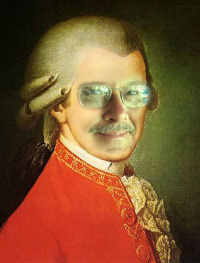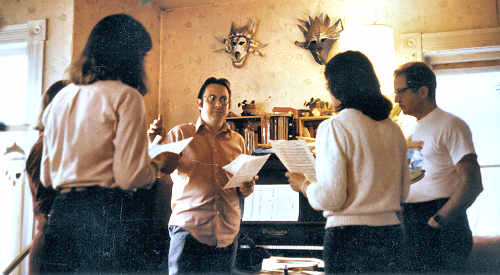A 365-Day Project
"We Are All Mozart"
A project to create
new works and change
the perception of the
music of our time.


 July 15, 2006
July 15, 2006 
We have not reached the end of the human voice.
The crisis deepens in the Middle East, with calls to prayer and cries of the helpless and droning news reporters and cheerfully singing commercials streaming out of our postmodern media centers.
The world's diversity grabs the ear: harmonic twirls of Tuvan throat singers, quiet subterranean roars of Tibetan monks, ringing sweetness of Javanese Gamelan singers, narrow brassiness of Chinese operatic sopranos, children exchanging melody in Central Africa hockets, happily raucous group chanting for Thai weddings, roundly bubbling Japanese pop divas, open-tuned bumpiness of briefly trendy Bulgarian women, Omaha hollow and covered drum-propelled ceremonial singing, a plaintive Appalachian lullaby, the calls to prayer that sound from minaret and echo through streets or from tiny radios, broad and deep Welsh men singing hymns in close harmony.
There are the expected and unexpected voices of the classical realm: tightly-fused voices with unstrained purity in Mary Jane Leach's Ariadne's Lament or my Super Flumina Babylonis, Erling Wold creating clear-voiced unmannered melody in A Little Girl Dreams of Taking the Veil, Eve Beglarian and Phil Kline re-inventing the classical song with their Bilitis Project, the calculated super-melodies of the David Hykes Harmonic Choir, the peculiar nasal roundness of Thomas Buckner's classic baritone or the intimate clarity of Beth Griffith's soprano, and the touchstone Stockhausen Stimmung.
Some voices speak clear meaning, such as Eve Beglarian's open-eyed post-9/11 Five Things, Maria de Alvear's unabashed ritual for orchestra and voice Sexo, Robert Ashley's droopingly dispassionate classic She Was a Visitor, Joan LaBarbara's mysteriously overlapping as lightning comes, in flashes, Harry Partch's pinched western narration in Barstow and Delusion of the Fury, the musically driven wordplay in Gary Barwin's Martin's Idea, the poetic chanting of John Giorno in I Don't Need It, I Don't Want It, and You Cheated Me Out of It, and Pamela Z's entire opus.
It is also the electroacoustician's favorite source, the voice. The emotional spread written into Luciano Berio's Visage and carried off by Cathy Berberian, the slipping transformation from word to chant to pure sound of the radio voice in Steve Reich's It's Gonna Rain, the wondrous madness of cries and screams and shifting pitches and swoops in Kenneth Gaburo's Exit Music, the brooding darkness melded to strings in Isván Márta's Doom: A Sigh, the power-chord grandeur of the answering machine in Scott Johnson's John, Somebody, the mysterious pitch elegance of John McGuire's A Cappella with Beth Griffith's harmonics sliding in and out of the recorded syllables, or Jody Diamond's simple clarity scooping out a peaceful space into Larry Polansky's B'rey Sheet, the exquisitely refined sonic beauty of Carl Stone's sliding loops in Shing Kee, the confounding transformations of expectation in Noah Creshevsky's Jubilate, the chunky Eurocentric samples of every recording by N.N. und Ähnliche Elemente, the nasally resonant tube music of Brenda Hutchinson's Eeeee-yah!, and the braying madness of my sweaty Spammung.
These hardly touch the beginning of the present, much less the past with its melismatic improvisers, Mannerist choruses, operatic tenors, organ-grinding street singers, barbershop quartets, crystalline castrati and husky cambiatas, London market cries, or the quotidien expression with screams of pain, laughter and cries of children, babbling conversations, last vibrations of death -- and the droning reporters and cheerful commercials.
The fifty-plus references above form a syllabus for the place of the human voice in musical culture, but never touch the heart of the voice itself. It is a mysterious relationship between the voice and the ear. We never heard our own voices before the age of recording, but could recognize one among thousands. We know an old friend heard before her face comes around the corner. Our heads snap up at one particular singer whose sound we simply know. Even in a babble, one child's voice among dozens alerts a mother when it mutates from cry to cry-that-matters. And it's not limited to humans: Cats will claw at the loudspeaker if their own voices are played, even transposed down several octaves; they just know.
Deeply inside how we know, how we recognize, how we respond, how we feel the voice is a commonality of species. It is biologically bonded in animals, but particularly in humans where it evolved separately into sound and symbol, the concrete and the abstract. It is handled differently in the brain, so much so that the idea of using music as a replacement for language is still being explored. As Leonard Shlain explains in The Alphabet versus the Goddess, "Speech freed both hands and eyes, and it worked in the dark. Once there was agreement that the sound of the spoken word 'tree' symbolized the image of a tree, early people could refer to trees when none were in sight. This ability ... is so profound that it forms the great divide between all other animals and us."
Shlain articulates the distinction between sound and word, but the development of language did not dismantle sound in favor of speech. The voice-as-sound is the concrete -- a link, in fact, between the abstraction of music and the flesh of the breast. To hear a voice inside a clatter of electronics or a thrash of notes is to touch ourselves again, to reach through the sound and press palms with the image on the other side, the image of us, the image, indeed, of the we in the I. Electroacoustic music that morphs voice to electronics and back or transforms voice from the recognizable to the abstract and back reaches inside and brings forth our atavistic response -- and inhales us again. It is physically confusing.
Because the relationship of word-sound to symbol is so biologically embedded, composers must deconstruct phylogeny to resurrect the pre-symbolic voice -- at least if they want to break the reference to lullaby and its modern progeny, song. From Sequenza to The Fifth Element, part of the quest has been for voice without implication or symbolism, devoid of verbal syntax -- for the grail of a meaning-free glossolalia.
Biology is a rough dominatrix who insists that her voice is not merely another instrument. She alerts us to fakeness and fraud and vocal tricks. She warns us of chipmunks and protects us from Tarnhelm-clad Fafners and Siegfrieds. She denies false sibilants and exposes unwelcome harmonics. She will not allow us to cavalierly strip her words of meaning -- or stamp meaning on her sounds. She will give truth to our lies. Composing for her voice is unforgiving.
Several composers dance with biology and nearly achieve the impossible fusion of meaning and un-meaning, word and sound. Carl Stone's Shing Kee excerpts a pop singer's rendition of Schubert, looping it slowly until, organ-like, it becomes a long, breathing, sighing pulse. The words are still there, but sung over and over, their sub-dermal feel massages the verbal hemisphere into a pleasant numbness. We are recapitulant in womb-time, swimming in sound. It's not that we do not hear, but we do not care. Unlike Stone's music, Noah Creshevsky's Psalmus XXIII is in a constant state of re-invention, its title leading us to believe that a verbal meaning will be conferred by attentive listening. Instead, as I wrote in an (as yet upcoming) article, "Psalmus bears the exquisiteness of sound as St. Theresa bears her martyrdom with sexual ecstasy. The pure vocal sounds combined with gasps and cries are integrated with chantlike modal melody that evolves into a tonal, accompanied motet."
My work with the voice has ranged from traditional to outlandish. How much? I wasn't sure, so numerically obsessed, I just counted 220 pieces including voice in solo or choral form, extended or as spoken text, or as source material for electroacoustics. There are five pieces appropriate to mention here as examples of the dichotomy of sound and message. Body Language is built from mouth sounds -- not artificially scored ones, but sounds engaged in strenuous bodily activities, from eating through being sick. The piece is deeply disturbing to some 'thing' neither music-like nor word-like in the psyche. (Body Language has not been released.) i cried in the sun aïda is a dream piece using text heard completely expressed in a sleeping dream, weaving in and out of meaning and pure sound, layering a certain inexplicable frightfulness. The Moon is an extended voice treatment of Geof Hewitt's poem of the same name, again veering in and out of sound, where the listener struggles to extract the verbal substance (and is occasionally rewarded). How Can I Keep from Singing is a simple, resonant arrangement of the Shaker tune, where the meaning inhabits the syllables, but the hollow harmonies sometimes act alone. Finally, Super Flumina Babylonis loses some meaning because it is in Latin, but also focuses more on how the meaning propels the sound outward to become self-standing. (Some of my vocal pieces can be found here.)
The voice bridges our interior separation of god and goddess, joins the word-of/voice-of divide. It is our only expression and our most humbling one, capable of unbearable deceit and unequivocal honesty.
Note: Most of the music I've mentioned at the beginning of this commentary has been heard on Kalvos & Damian's New Music Bazaar. The site search includes all the playlists and composers, and the shows are archived for listening.

Rehearsing the Roxbury Union Congregation Church Choir in 1985. The choir doubled as "Il Gruppo Nuke Jitters" to perform contemporary music in concert, and recorded the source vocal material for In Bocca al Lupo and Echo. We are also featured singing Sumer is Icumen In on the CD accompanying Longman Anthology of British Literature. (Photo by Marty Goodman)